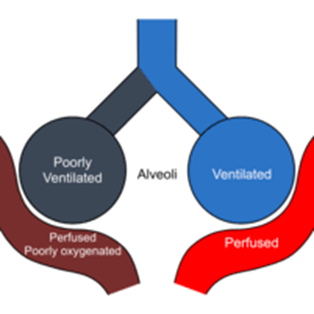Which of the following are manifestations of obstructive sleep apnea? (Select all that apply.)
(Select All that Apply.)
Easily getting back to sleep after awakening
Many episodes of apnea per night
Loud snort after breathing cessation
10 seconds or longer of breathing cessation 10 seconds or longer of breathing cessation
Daytime sleepiness
Frequent, loud snoring
Correct Answer : B,C,D,E,F
Choice A Reason:
Easily getting back to sleep after awakening is incorrect. This is not typically a manifestation of obstructive sleep apnea. Instead, individuals with OSA often experience fragmented sleep due to frequent awakenings caused by apnea episodes.
Choice B Reason:
Many episodes of apnea per night is correct. Yes, individuals with obstructive sleep apnea experience many episodes of apnea (complete cessation of breathing) or hypopnea (partial obstruction of airflow) per night. These episodes can occur multiple times throughout the night, disrupting normal sleep patterns.
Choice C Reason:
Loud snort after breathing cessation is correct. This is a characteristic manifestation of obstructive sleep apnea. Individuals with OSA often make choking, snorting, or gasping sounds after a period of breathing cessation as they attempt to resume breathing.
Choice D Reason:
10 seconds or longer of breathing cessation is correct. Yes, breathing cessation episodes in obstructive sleep apnea typically last for 10 seconds or longer. These prolonged episodes of apnea contribute to oxygen desaturation and disrupted sleep.
Choice E Reason:
Daytime sleepiness is correct. Yes, daytime sleepiness is a common symptom of obstructive sleep apnea. Disrupted sleep patterns and frequent awakenings during the night can lead to excessive daytime sleepiness, fatigue, and decreased alertness.
Choice F Reason:
Frequent, loud snoring is correct. Yes, frequent, loud snoring is a hallmark symptom of obstructive sleep apnea. Snoring occurs due to the partial obstruction of airflow in the upper airway during sleep.
Nursing Test Bank
Naxlex Comprehensive Predictor Exams
Related Questions
Correct Answer is B
Explanation
Choice A Reason:
Flail chest is incorrect. Flail chest is a condition characterized by multiple rib fractures, causing instability in the chest wall. While it can lead to respiratory distress, it doesn't directly cause ventilation-perfusion (V/Q) mismatch. Instead, it impairs the mechanics of breathing by compromising chest wall integrity.
Choice B Reason:
Emphysema is a chronic obstructive pulmonary disease (COPD) where the alveolar walls are destroyed, leading to a loss of surface area for gas exchange. This results in areas of the lungs that are well-perfused but poorly ventilated, causing a V/Q mismatch. The damage to alveoli leads to impaired ventilation, while blood flow may still be adequate, leading to hypoxemia (low oxygen levels in the blood).
Choice C Reason:
CHF primarily affects the heart’s ability to pump blood effectively, leading to pulmonary congestion and impaired gas exchange. However, it typically causes diffusion defects rather than a direct ventilation-perfusion mismatch. V/Q mismatch may occur secondary to pulmonary edema, but it’s not the primary mechanism of respiratory failure in CHF.
Choice D Reason:
Guillain-Barré syndrome is incorrect. Guillain-Barré syndrome (GBS) is a neurological disorder that affects the peripheral nervous system, leading to muscle weakness and paralysis. While respiratory muscle weakness can occur in GBS, it doesn't directly cause ventilation-perfusion (V/Q) mismatch. GBS primarily affects nerve function rather than lung function.

Correct Answer is B
Explanation
Choice A Reason:
Prodrome is incorrect. The prodrome phase occurs before the onset of the headache and can last for hours to days. During this phase, individuals may experience subtle changes that serve as warning signs of an impending migraine attack. Common prodromal symptoms include fatigue, mood changes, food cravings, increased thirst, and heightened sensitivity to light or sound. Tingling of the face and blind spots in the eyes are not typically associated with the prodrome phase.
Choice B Reason:
Aura is correct. The aura phase of a migraine typically occurs before or during the headache phase and involves neurological symptoms. Aura symptoms can include visual disturbances such as blind spots, zigzag lines, or flashing lights, as well as sensory symptoms like tingling or numbness, often starting in one part of the body and spreading gradually. The tingling of the face and blind spots in the eyes described by the client are consistent with the aura phase of a migraine.
Choice C Reason:
Postdrome is incorrect. The postdrome phase occurs after the headache phase and can last for hours to days. During this phase, individuals may experience lingering symptoms such as fatigue, difficulty concentrating, mood changes, and muscle aches. While some individuals may experience visual disturbances during the postdrome phase, the tingling of the face and blind spots in the eyes described by the client are more characteristic of the aura phase.
Choice D Reason:
Headache is incorrect. The headache phase of a migraine is characterized by moderate to severe throbbing head pain, often accompanied by other symptoms such as nausea, vomiting, and sensitivity to light or sound. While visual disturbances can occur during the headache phase, the tingling of the face and blind spots in the eyes described by the client precede the onset of headache, suggesting the aura phase rather than the headache phase.
Whether you are a student looking to ace your exams or a practicing nurse seeking to enhance your expertise , our nursing education contents will empower you with the confidence and competence to make a difference in the lives of patients and become a respected leader in the healthcare field.
Visit Naxlex, invest in your future and unlock endless possibilities with our unparalleled nursing education contents today
Report Wrong Answer on the Current Question
Do you disagree with the answer? If yes, what is your expected answer? Explain.
Kindly be descriptive with the issue you are facing.
